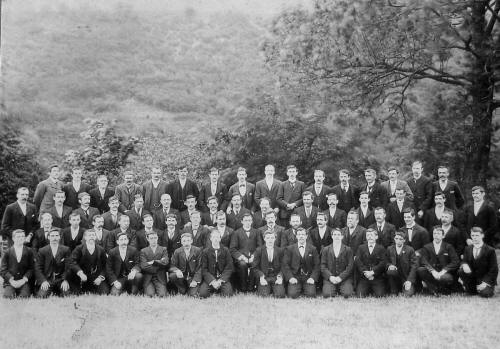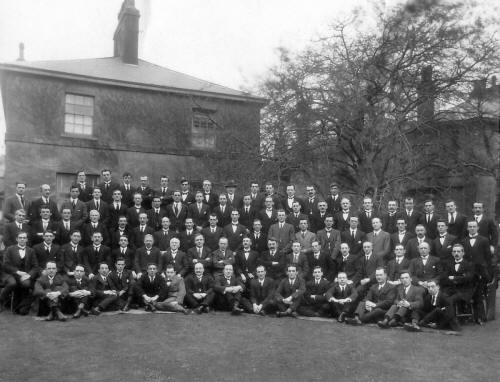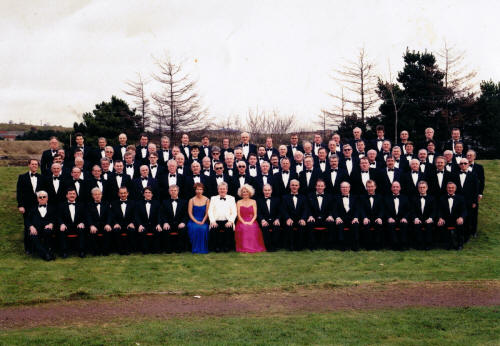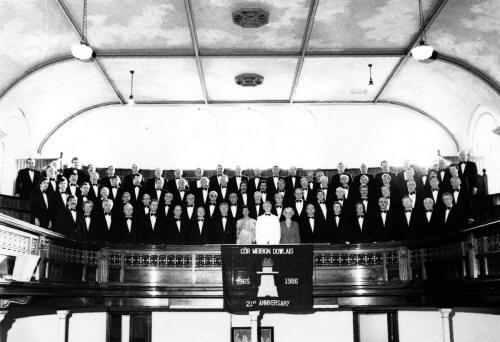|
Dowlais Iron Works and
Male Voice Choir
By Carl Llewellyn
Before the Iron Works were established in Dowlais there was no
distinct name to the locality, the Welsh name Dowlais is unique,
it’s not duplicated in any other part of Wales. One
interpretation, “Dow” is derived from “Ddu” the Welsh word for
black and “Lais” refers to the sound of rivulet hence “Black
rivulet”, probably the name originated as a result of the Iron
industry in the area which caused the rivulet to change its
crystal appearance, to a polluted black murky colour, as a
result of coal and Iron waste. The interpretation favoured by
Dowlais choristers refers to two local streams, merging, to
create the concept of “Two voices, blending” as one.
The following narrative is a short synopsis of the choir’s
history and its close association, firstly with Dowlais Iron
Work and secondly with GKN.
This is an historical account of the formation of male choral
singing in the locality of Dowlais, from its initial formation
to the present day. With development of the iron and coal
industries associated with the Iron works and collieries at
Dowlais made famous since 1767 by John Guest from Broseley in
Staffordshire, by 1845 Dowlais Iron Works became the biggest
ironworks in the world employing 8800 employees. Men and women
throughout Wales and England heard of the opportunities to earn
a higher wage than the pittance they were being paid as
agricultural workers where poverty was a way of life,
The Welsh have always been renowned for their singing,
whenever there is a group of Welshmen or women congregate
together for social interaction, there is usually a cord struck
followed by an outburst of song. With the influx of emigrants to
Dowlais in the seventeenth century and the dangerous and harsh
working conditions they endured, three activities gave the
working classes opportunities to escape from their oppressed
environment, the imbibing of alcohol, sporting activities or
associating themselves with religious fraternities which
embraced hymn singing. Singing was one of those leisure
activities that a helped alleviate the drudgery of every day
life. In the mid 1800’s. Dowlais was like the Klondike, in the
early establishment of the community, it encapsulated a
collection of people from all parts of the
United Kingdom and beyond, with such a high density of
population those who shared a passion for in choral singing
would usually attend a chapel or church, these spiritual places
promoted the choral activity, where children were taught the
rudiments of tonic Sol-fa through a modulator.
One tradition of the Welsh is to complete at
festivals
of
literature
and music called an Eisteddfod,
which dates back to the 12th century. Due to the
amount of small choirs in Dowlais at that period Eisteddfods
were organsied frequently to give opportunities to choirs to
strive for excellence among choral competitors.
In Dowlais in the 1890’s there was an abundance of choirs
representing various organisations. A particularly good example
of this is the Merthyr Valley iron town with the district of
Dowlais produced between 1880-1900 the Dowlais Glee Party, the
Dowlais Harmonic Society, the Dowlais Choral Society, the
Dowlais Philharmonic, the Dowlais Choral Union, Dowlais and
Merthyr United, the Dowlais Temperance Union. The two prominent
mixed choirs in existence were “The Dowlais Temperance Choir”
and “The Dowlais Philharmonic Society” the latter originating in
1893. Male Voice Choirs in the area were not so prominent in
Dowlais, resulting in few male choral groups in existence.
One such Male Voice Choir singing group was formed in the
early 1890’s; its conductor was Mr William James, formed to
enter the Eisteddfod at Abergavenny. Mr. Thomas Evans (Gwent
House) a local philanthropist was approached and accepted the
position to be the president of the Male Voice Choir.
In 1894 there was a formation of another Male Voice Choir
under the direction Mr John Davies, Alma Street, resolved to
enter the competition at the Treorchy Eisteddfod. By 1897 the
Male Voice Glee Society led by Mr Williams James disbanded,
leaving the remaining Male Voice Party under their leadership of
Mr. John Davies to carry on the male voice tradition.
In1899 the renowned local musician Harry Evans F.R.C.O.,
conductor of Dowlais Philharmonic Society had rendered a number
of concert successes. Mr Evans was persuaded after some
contemplation to enter a male voice
choir for competition at the 1900 Liverpool National
Eisteddfod. With Harry Evan’ distinguished reputation as a
conductor and musician; it was a foregone conclusion only
choristers with quality voices who could also read Sol-fa or old
notation would be considered. When it came to voice tests only
the crème de la crème were accepted. Such was the calibre of the
choristers; their musical backgrounds were chapel presenters,
soloists, church and chapel organists, and local choir
conductors. Such was the level of singing the choir soon gained
a reputation as being a prestigious organisation. Lord
Wimborne was invited to become President of the Dowlais Male
Voice Party he expressed his pleasure in accepting the
position.
Ivor Bertie Guest, 1st Baron Wimborne
(1835-1914),
was the son of Sir
John Josiah
and
Lady Charlotte
Guest, and an uncle-by-marriage of
Winston
Churchill. His middle name Bertie came from his
mother's family, the Earls of Abingdon
At one rehearsal Lord Wimborne addressed the
choristers expressing delight with the singing and further more
hoped they would be successful at Liverpool, part singing, more
than any other form of vocal music appealed to him and he had
been very much struck by their rendition of the difficult
sections. His lordship, in conversation with Mr. Harry Evans
complimented the conductor upon the high state of the
proficiency of the party.
After a triumphant win at the 1900 Liverpool National
Eisteddfod, the choir gained high status in the male voice
arena. By 1903 with adjudications and offers for a guest
conductor, Harry Evans handed the baton of the Male Voice Choir
to Mr W.J. Watkins one of his prodigies, who had been the
choir’s accompanist.
By 1906 Mr Harry Evans F.R.C.O. was invited to Liverpool to
become the conductor of the Liverpool Welsh Union Choral
Society. He also accepted the position of organist for the Great
George Street English Congregational Church in Liverpool which
as long been recognised as the Tabernacle of the Liverpool
City.
In 1909 the Male Voice Choir completed at the Welsh national
Eisteddfod in London, and successfully gained victory and won
first prize, by 1910 the choir had disbanded.
In the same year the Dowlais Philharmonic Male Voice Choir
disbanded, left the name “Dowlais Male Voice Choir” in a state
of Nirvana. As one fraternity dies another is reborn, as was the
case with Cor Meibion Penywern, another male choir in the
principality, founded by seventeen young men of the local
Congregational Chapel. Evan Thomas “Alaw
Morlais”, a native of Penywern, was appointed the conductor.
Evan Thomas was employed as collier in one of the collieries
owned by the Messrs Guest, Keen, and Nettlefolds, Ltd.
When King George and Queen Mary visited the Dowlais Steel
Works in June 1912, an invitation by Messrs Guest, Keen, and
Nettlefolds, Ltd., was extended to the Penywern Male Voice
Choir to take part in celebrating the visit of their Majesties.
In August 1914 Mr Tudor Davies M.E., came to Dowlais
as deputy agent, after he appointed to the management of Guest,
Keen and Nettlefolds, Ltd. When Mr. Howell R. Jones became
general manager of the firm early in 1915, Mr. Davies was made
chief agent of the Dowlais collieries. With his advent to the
town he took an active interest in its welfare, and subsequently
was invited to become president of the Penywern Male Voice Choir
in 1914.
In the 1920’s a decision was made by the committee of Cor
Meibion Penywern to rename the choir, “Dowlais Voice Male
Choir”. The original title did not give a true representation of
the area where the members resided; also the name associated a
link with a reputable male chorus from a bygone era
1921 the choir were invited by Messers Guest, Keen, and
Nettlefold Ltd., to a function at Cardiff given in honour of
the Iron and Steel Trades Institute.
For many years inception of this choir Mr. Howell R. Jones
J.P. general manager had taken an exceptionally kindly
interest in the choir, and representatives to him from time to
time had always been met with greatest courtesy.
He had grated the choir many privileges, such as the Guest
Memorial Hall when it became at the disposal of the Choir with
electricity and heating free of charge.
One of
the choir’s patrons was Merthyr Tydfil born Mr. H. Seymour
Berry (later became Lord Buckland) he became part of the
management board of
Guest, Keen and Nettlefold
in 1920 and became its
chairman
1927, at a rehearsal in 1921 he made a
presentation of a valuable addition to the choir, a new piano
at the Guest Testimonial Library.
From its inception 1910 until the 1930’s the choir became a
fierce competitor, its continuous winning at Eisteddfods and
competitions made other choirs tremble at the name of Dowlais,
even Dylan Thomas the famous Welsh poet had known of the Dowlais
Male Choir and made reference to them in one of his works “How
are the tenor in Dowlais”
Due to the depression of the 1920’s numbers dwindled with
choristers leaving the choir to seek work in the UK and abroad
depleted the membership, thankfully the choir managed to survive
until 1939, when war was declared between Great Britain and
Germany a number of choristers were conscripted into the armed
services, the choir became in a state of Nirvana for a couple of
years but reformed themselves as Glee party between 1941-46.
It was nearly forty five years since the present Dowlais Male
Choir was formed. The original meeting was made up of employees
of the Messers Guest, Keen, and Nettlefold Ltd who’d
formerly been members of the disbanded Guest Keen Glee Party
under the baton of Elwyn Morgan in the 1950’s. One of
prominent activists responsible for its formation was Des Kelly
an employee of Messers Guest, Keen, and Nettlefold Ltd
who planted the seed among his fellow work colleagues who’d
previously been choristers in the Guest Keen Glee party, with
Des’s pursuit in finding if any of his work colleagues were
interested in forming a male voice choir there seemed to have
been a favourable response to his endeavours.
A meeting was arranged on Wednesday October 27th
1965 at the Guest Keen Memorial Club. Thirteen men employed by
Messers Guest, Keen, and Nettlefold Ltd turned up, these
are the men who are known to have attended the first meeting,
Des Kelly, Meurig Price, John Francis, Ron Pope, Arfon Price,
Austin Adams, Les Williams, Mostyn Davies, Bernard Barrett,
Edgar Hughes, Tom Kinsey, and Adrian Newman. All those present
were obviously disappointed with such a poor response but the
low numbers did not deter those present; a proposal was made to
hold another meeting to see if anymore-prospective members would
be interested. At the subsequent meeting twenty-five men
appeared, this was rather more encouraging, and that meeting it
was decided make an announcement, by displaying some coloured
posters, the first rehearsal of the "Newly formed male voice
choir" would take place in the Guest Keen Memorial Club on
Wednesday 10th November.
It was decided to invite Mr. Cyril Tasker, Manager of
Guest, Keen, & Nettlefolds to become the choir’s first
President. In later years other Managers, Mr Philip Green and
Mr John Owen became Vice Presidents
The choir went from strength to strength and achieved first
prize in the National Eisteddfod in Ruthin. Some of the original
members are still active members of the current choir
Through the ages a majority of male voice choristers living
in Dowlais were employed by, firstly the Dowlais Iron Works
and subsequently GKN whether they worked in the Steel works, the
surrounding collieries, or companies offices.
GKN and Dowlais Male Choir continued
their association and the choir has appreciated the sponsorship
and support of GKN over the years, and were privileged and
delighted to be invited to participate in the celebration of
250 years of Guest Keen & Nettlefolds. |




